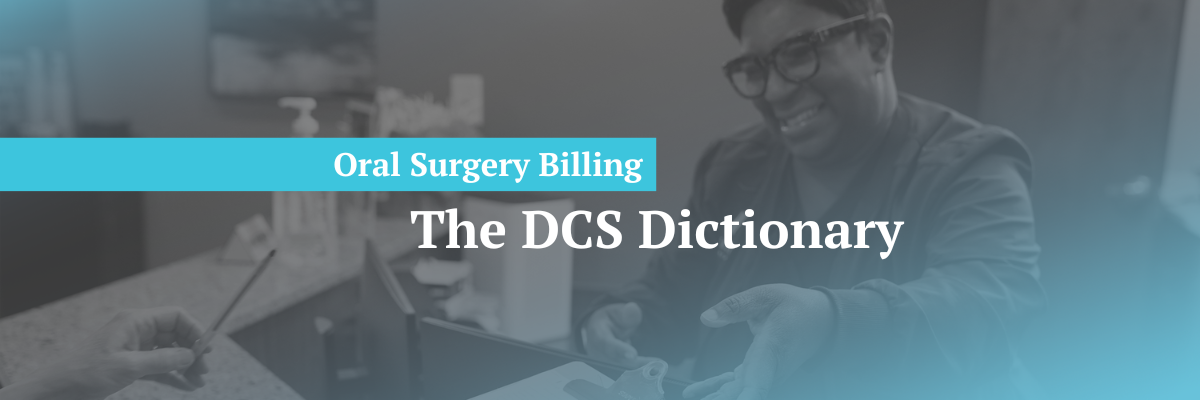Navigating the maze of oral surgery billing can be as perplexing as reading a map with no legend. It's a world where confusion over vague terms, abbreviations, and acronyms can lead to costly mistakes.
But don’t worry: This DCS Dictionary series is your map through the maze of oral surgery billing terms.
Here at DCS, we are fluent in the language of insurance billing, including that of oral surgery practices. As full-service revenue cycle management (RCM) providers, we work with dental businesses of all shapes, sizes, and specialties to ensure they have a smooth and efficient billing process that creates consistent cash flow.
We have a department dedicated to oral surgery billing, with specialists skilled in the unique requirements needed for fast and accurate reimbursement of oral and maxillofacial surgery (OMS) providers.
We’re here to clear up some of the confusion in OMS by defining 5 commonly misunderstood words in the oral surgery billing process. Which of these terms have you been using correctly — or incorrectly?
1. Electronic Medical Record (EMR)
Electronic medical record, or EMR, refers to a digital system or software that stores comprehensive patient health information, treatment records, and clinical data in a structured and electronic format.
This digital record includes information about a patient's medical history, dental history, surgical procedures, medications, allergies, and other relevant health details.
EMRs are designed to facilitate efficient record-keeping, streamline patient care, improve accuracy, and enhance communication among healthcare providers within the oral surgery field.
Dental Sleep Practice explains:
“The implementation of electronic records in medicine and dentistry coupled with workflow redesign create a time-saving, efficiency-boosting leap forward for practices across the country.
Dentists lag slightly behind our physician colleagues when it comes to electronic records adoption. However, the trend is increasing, and one recently published article showed adoption to be 77% in a dental setting.”
Electronic medical records play a crucial role in managing patient information, treatment planning, and ensuring the delivery of safe and effective oral surgical care.
2. Diagnosis codes and cross-coding
Diagnosis codes and cross-coding refer to the process of assigning specific alphanumeric codes to describe a patient's oral or dental condition for billing and insurance purposes.
These codes are part of a standardized system used in healthcare to communicate information about a patient's diagnosis or medical condition to insurance companies. They are required on an insurance claim to receive reimbursement.
Let’s differentiate these two terms, which are related but not interchangeable.
- Diagnosis Codes: These are alphanumeric codes from the International Classification of Diseases, 10th Revision (ICD-10) or other similar coding systems. Oral surgeons use diagnosis codes to document a patient’s specific dental or oral health issue, and explain why the procedure took place.
- Cross-Coding: Cross-coding refers to translating a medical CPT code to a dental CDT code or vice versa. This is often necessary when oral surgeons need to bill medical insurance plans for dental procedures that have a medical necessity component.
Related: CDT codes vs CPT codes: What’s the difference?
Coding is challenging in the oral surgery space because you are dealing with both dental and medical codes, but it’s crucial that they’re used correctly. Ensuring your codes are accurate is essential for prompt reimbursement of your claims, as well as maximizing your overall revenue.
3. Simple extractions vs surgical extractions
Simple extractions and surgical extractions are two distinct categories of tooth removal procedures, each with its own purpose. So let’s clear up which is which.
Simple extractions: Involve the removal of a tooth that is visible and accessible in the oral cavity without the need for extensive surgical techniques. During a simple extraction, a dentist or oral surgeon uses forceps to grasp the tooth and gently remove it from its socket. This procedure often requires only local anesthesia.
Surgical extractions: These are more complicated than a simple extraction because they involve the removal of teeth that are not easily accessible, such as impacted teeth, broken teeth, or teeth with complicated root structures. Surgical extractions may involve incisions in the gum tissue, bone removal, and sometimes the use of stitches. These procedures are typically performed under local anesthesia, with or without sedation, depending on the complexity.
The key difference in these two extractions is their complexity. To avoid claim denials and payment delays, it’s important to understand these differences so they can be reported on your insurance claims accurately.
4. Medical claims vs dental claims
In an oral surgery practice, your team frequently files both medical and dental insurance claims for each patient. Understanding the fundamental differences between medical and dental claims will help your team submit clean claims to avoid denials, reduce re-work, and collect more payments sooner.
Medical claims and dental claims are associated with different types of procedures and services, and they follow separate billing and coding processes. To be specific…
A medical claim requires:
- Diagnosis pointer
- Place of service
- Current Procedural Terminology (CPT) and/or Healthcare Common Procedure Coding System (HCPCS) national codes
- ICD-10-CM diagnoses codes
- Modifiers
A dental claim requires:
- Current Dental Terminology (CDT) code
- The fee
- Provider information
- Patient information
- Subscriber information
- Clinical notes
- Attachment information
- Initial placement or date of initial placement
Read more: Medical claims vs dental claims in dental billing
Medical claims require a different claim form than dental claims, and many practice management software programs will have both form templates available. Forms are updated occasionally, and the current form must be used to prevent claim denials.
The current medical claim form is the CMS 1500 (02-12), which was last updated in 2021, while the current dental claim form is the 2024 ADA claim form.
5. Sedation types
Various types of sedation are used to help patients feel relaxed, comfortable, and pain-free during surgical procedures. The sedation type used depends on the patient’s needs, the complexity of the surgery, and the dentist or oral surgeon’s expertise.
The sedation type must be differentiated and documented on your insurance claims. Here are 5 different sedation types:
- Local Anesthesia: Involves the injection of a numbing agent such as lidocaine into the area where the surgery will take place.
- Nitrous Oxide (Laughing Gas): A gas that patients inhale through a mask. It induces a relaxed and euphoric state, reducing anxiety and pain perception.
- Oral Conscious Sedation: Involves the administration of oral medications, usually in pill or liquid form, before the surgery. These medications induce drowsiness and a state of deep relaxation.
- Intravenous (IV) Sedation: Involves the administration of sedative medications through a vein. It provides a deeper level of sedation than oral conscious sedation and allows for precise control of the patient's level of consciousness.
- General Anesthesia: Induces a deep state of unconsciousness where the patient is completely asleep and unaware of the surgery. It is administered through inhalation or intravenous methods, and is typically used for extensive or complex oral surgery.
Related: What is the missing tooth clause? 4 questions answered for dentists
Access the DCS Knowledge Network to ensure accuracy and maximize profits
To recap, we’ve defined the following oral surgery terms:
- Electronic Medical Record (EMR)
- Diagnosis codes and cross-coding
- Simple extractions vs surgical extractions
- Medical claims vs dental claims
- Sedation types
Understanding these terms can streamline your billing process by helping your team avoid mistakes that lead to claim denials — which then pile up on your aging report and cause dips in your revenue.
When you partner with DCS, you’ll gain access to our DCS Knowledge Network through your Account Specialist. This means you will have access to over 100 more experts who will help your team understand billing terms like these, resulting in faster and more accurate collections, plus a consistent cash flow for your dental business. Bill at your oral surgery practice with confidence: Book a free 30-minute call with DCS today.
Related Posts
Dental revenue resources from Dental Claim Support




